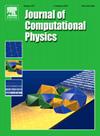A moment-of-fluid interface reconstruction using polygon inscribed in ellipse in 2D
IF 3.8
2区 物理与天体物理
Q2 COMPUTER SCIENCE, INTERDISCIPLINARY APPLICATIONS
引用次数: 0
Abstract
In this paper we consider interface reconstruction as a problem of approximating the intersection of a material body with a particular computational cell. This intersection results in a fragment of material, or “FOM”, whose boundary is formed by parts of the interface and the cell boundary. The most general characteristics of any shape, and a FOM in particular, are its moments, such as the zeroth moment (the area) and the normalized first order moment (the centroid). In this paper, we assume that the moments of the FOM are known a priori, which we will refer to as reference moments. In this context, we develop a new class of moment-of-fluid (MOF) method [3], [1], [4], which approximates a FOM by trying to match the moments through an optimization procedure. Our new addition to the MOF family, MOF-PIE, centers on constructing approximate FOM polygons from discretizing ellipses using varying numbers of vertices. As in other MOF methods, this reconstruction procedure is cell-local and involves a non-linear optimization procedure to minimize a cost function constructed from area moments while conserving area. The optimization is performed using the Levenberg-Marquardt algorithm with a cost function involving up to third-order area moments. Due to the reconstruction being based on an ellipse, this reconstruction also has the unique ability to recover shapes laying entirely inside a computational cell and can be tuned to better resolve cell-local curvature. The new method has been implemented in the open-source Interface Reconstruction Library (IRL) [7], [8], making it publicly available. IRL is a collection of computational geometry and interface reconstruction methods designed to be both easy to use and computationally performant. Using this implementation, we perform and present numerous single-cell and whole-mesh reconstruction cases, comparing results to existing MOF methods.
求助全文
约1分钟内获得全文
求助全文
来源期刊

Journal of Computational Physics
物理-计算机:跨学科应用
CiteScore
7.60
自引率
14.60%
发文量
763
审稿时长
5.8 months
期刊介绍:
Journal of Computational Physics thoroughly treats the computational aspects of physical problems, presenting techniques for the numerical solution of mathematical equations arising in all areas of physics. The journal seeks to emphasize methods that cross disciplinary boundaries.
The Journal of Computational Physics also publishes short notes of 4 pages or less (including figures, tables, and references but excluding title pages). Letters to the Editor commenting on articles already published in this Journal will also be considered. Neither notes nor letters should have an abstract.
 求助内容:
求助内容: 应助结果提醒方式:
应助结果提醒方式:


